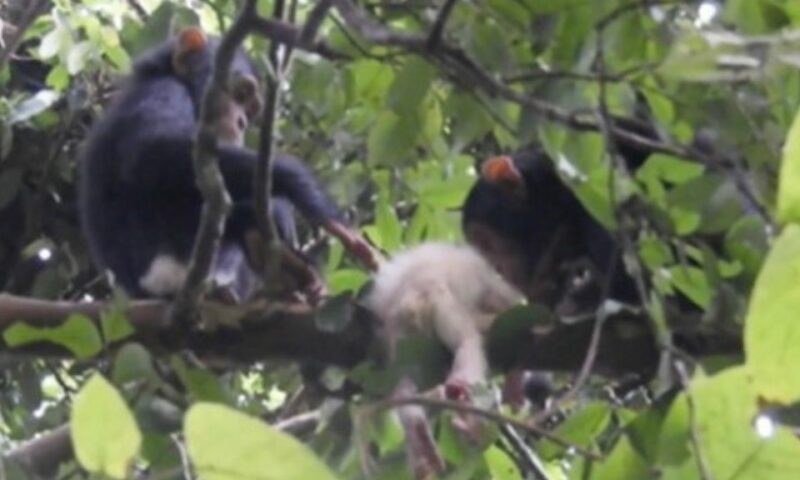The scientists noted that only a handful of nonhuman primates with albinism have been spotted in the wild in the past. These included a few toque macaques (Macaca sinica), bonnet macaques (Macaca radiata) and spider monkeys (Ateles geoffroyi), and among the great apes, an albino western lowland gorilla (Gorilla gorilla gorilla) was once captured in the wild as an infant and then kept in captivity until its death in adulthood.
The only albino chimp ever reported was a western chimpanzee (Pan troglodytes verus) named Pinkie, who was found as an infant and sheltered in the Tacugama Chimpanzee Sanctuary in Sierra Leone until her unexpected death at age 9. Because Pinkie was collected from the wild at just a few weeks old, scientists didn’t have the opportunity to observe her interactions with wild chimps. Now, the new study provides a unique glimpse into the brief life of an albino ape in the wild.
The albino chimp was spotted among a population of eastern chimpanzees (Pan troglodytes schweinfurthii) in Uganda’s Budongo Central Forest Reserve. At the time of the young chimp’s birth in summer 2018, the chimp community consisted of about 75 individuals.
A 19-year-old female chimp, which the researchers referred to as “UP,” was known to be pregnant in January 2018, and on July 15 of that same year, she was seen carrying a “white” infant, later confirmed to be a male. Judging by the infant’s size and the last recorded sighting of UP, the team estimated that the albino newborn was about 2- to 2-and-a-half weeks old.
Later on July 15, a pair of adult chimps encountered UP and the albino infant and began producing “alarm hoos and waa barks,” sounds that chimps often make when facing potentially dangerous animals, like snakes and bush pigs, the authors wrote. Another male chimp heard these hoos and barks, as well as UP screaming, and rushed into the area; he struck UP before clambering up a tree and starting to produce alarm hoos and waa barks, as well.
Over the next few minutes, several more adult chimps entered the area and joined in the ruckus. But a few adult chimps remained quiet and simply watched UP and the infant attentively; one calm individual even approached and reached out to UP with its hand.
At some point, UP rushed up a tree, with the infant clinging to her chest, and stayed there for some time before climbing down and ducking from sight inside a dense thicket. Researchers spotted her and the infant a few more times that morning. On one occasion, an adult male let out a “tantrum scream on encountering (likely unexpectedly) UP and the baby at a close distance.”
Just days later, on July 19, the young chimp met his end.
Following the infant’s death, an adult male draped the carcass over a branch. Over the course of the next few hours, 10 of the chimps approached the body, sniffing, inspecting and sometimes grooming or stroking the dead infant. Eventually, the chimps left, and the research team collected the body for an autopsy, noting that the infant’s skin, hair and eyes lacked pigmentation. The 4.6-pound (2.1 kilograms) chimp had sustained “substantial injuries,” including deep gashes in its head and a crack in its skull, revealing damaged brain tissue beneath.




